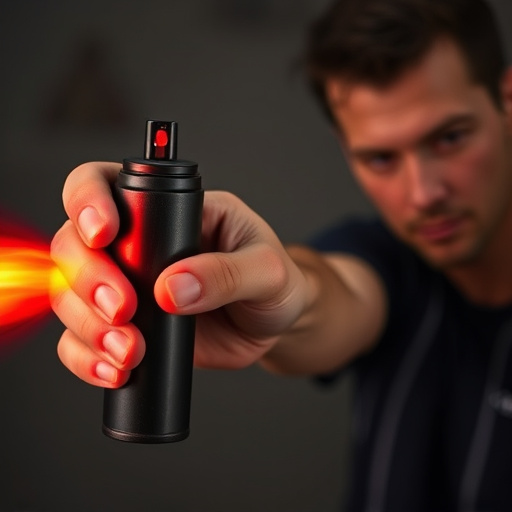Non-lethal pepper spray defense systems, utilizing oleoresin capsicum (OC) to temporarily disable individuals, have become a vital tool for law enforcement globally. These advanced devices offer a safe and effective alternative to lethal force in high-risk situations like crowd control and riot dispersion. Popular for self-defense and crowd management, these systems deter threats with controlled bursts of capsaicin, prioritizing safety while enabling controlled recovery from incidents. However, their adoption requires rigorous training, strict protocols, and compliance with varying global regulations to prevent misuse and maintain public trust.
“Discover the revolutionary power of tactical inflammatory spray defense systems—a non-lethal yet potent tool for law enforcement and security. This comprehensive guide explores the inner workings, components, and diverse applications of these advanced pepper spray defenses. From understanding their unique functionality to delving into safety considerations and legal frameworks, we demystify this game-changing technology. Optimize your knowledge about non-lethal pepper spray defense systems and their impact on modern security strategies.”
- Understanding Non-Lethal Pepper Spray Defense Systems
- Components and Functionality of Tactical Inflammatory Spray
- Applications in Law Enforcement and Security
- Safety Considerations and Legal Aspects of Using Pepper Spray Defenses
Understanding Non-Lethal Pepper Spray Defense Systems
Non-lethal pepper spray defense systems have gained significant attention as a crucial tool for law enforcement and security personnel worldwide. These advanced devices are designed to incapacitate individuals temporarily, providing a safe and effective response during high-risk situations. Unlike lethal force, which can have severe consequences, non-lethal pepper spray offers a less harmful alternative, ensuring the safety of both officers and suspects.
The primary function of these systems is to disrupt an individual’s vision and respiration by releasing a potent yet non-deadly chemical agent, commonly known as oleoresin capsicum (OC). When deployed accurately, the spray creates a temporary defense perimeter, allowing authorities to control and deescalate potentially dangerous scenarios. This tactical approach is particularly useful in crowd control, riot dispersion, and personal protection situations, making it an indispensable asset for modern law enforcement agencies.
Components and Functionality of Tactical Inflammatory Spray
Tactical inflammatory spray, often referred to as non-lethal pepper spray defense systems, is a powerful tool designed for law enforcement and security personnel. These advanced devices typically consist of three main components: a container, a dispensing mechanism, and an active ingredient—usually oleoresin capsicum (OC). The OC is derived from chili peppers and is known for its irritant properties, causing temporary blindness, coughing, and difficulty breathing when sprayed onto the target’s face or eyes.
Upon activation, the spray releases a cloud of occlusive particles that adhere to the attacker’s skin and mucous membranes, creating a painful and disorienting effect. The functionality lies in its ability to incapacitate an aggressor without causing permanent harm, making it a popular choice for self-defense and crowd control situations. This non-lethal pepper spray defense system offers a swift response, providing users with a crucial advantage during high-risk encounters.
Applications in Law Enforcement and Security
Law enforcement agencies have long relied on non-lethal pepper spray defense systems as a crucial tool for crowd control and managing volatile situations. This tactical inflammatory spray offers an effective, yet safe alternative to firearms, providing officers with a powerful deterrent to disrupt and disperse potential threats or rioting crowds. By employing controlled bursts of capsaicin, the active ingredient in chili peppers, law enforcement can neutralize and subdue individuals without causing permanent injury or death.
In addition to crowd management, these systems are valuable for securing high-risk facilities and critical infrastructure. Security personnel can deploy them as a first line of defense against intruders or hostile actors, providing a rapid response option that minimizes damage and risk while allowing for a controlled recovery. The versatility and non-lethal nature of these pepper spray defenses make them indispensable tools in modern law enforcement and security operations, ensuring the safety of both citizens and officers alike.
Safety Considerations and Legal Aspects of Using Pepper Spray Defenses
The use of non-lethal pepper spray defense systems raises important safety considerations and legal aspects that must be addressed. These systems, designed to incapacitate or deter potential threats, involve the deployment of capsaicin, the active ingredient in chili peppers, which can cause temporary blindness, coughing, and difficulty breathing. Ensuring proper training for individuals handling these devices is paramount to minimize risks and prevent misuse. Law enforcement agencies and private security firms must adhere to strict protocols, including regular maintenance of equipment, clear communication during operations, and post-incident medical monitoring for affected individuals.
Moreover, the legal framework surrounding pepper spray defenses varies significantly across jurisdictions. Many countries have specific regulations governing its use, focusing on proportionality and necessity. Civil liberties groups advocate for stringent oversight to prevent abuse and ensure that non-lethal force is employed only as a last resort. Understanding local laws and adhering to international human rights standards are essential for organizations employing these systems to avoid legal repercussions and maintain public trust.
Non-lethal pepper spray defense systems, or tactical inflammatory spray, offer a powerful tool for law enforcement and security professionals. By utilizing specialized components that create an intense but temporary incapacitation, these systems provide a safe and effective alternative to lethal force. With various applications proven in real-world scenarios, the strategic deployment of non-lethal pepper spray can deescalate tensions and protect both citizens and officers. However, it’s crucial to navigate safety considerations and legal aspects to ensure responsible use, making these systems a valuable addition to modern security strategies while maintaining public trust.
